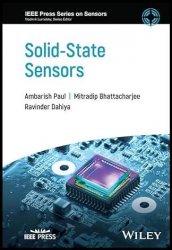Solid-State Sensors
- Добавил: literator
- Дата: 12-10-2023, 03:12
- Комментариев: 0
 Название: Solid-State Sensors
Название: Solid-State SensorsАвтор: Ambarish Paul, Mitradip Bhattacharjee
Издательство: Wiley-IEEE Press
Год: 2024
Страниц: 450
Язык: английский
Формат: pdf (true), epub
Размер: 32.1 MB
A thorough and up-to-date introduction to solid-state sensors, materials, fabrication processes, and applications.
Solid-State Sensors provides a comprehensive introduction to the field, covering fundamental principles, underlying theories, sensor materials, fabrication technologies, current and possible future applications, and more. Presented in a clear and accessible format, this reader-friendly textbook describes the fundamentals and classification of all major types of solid-state sensors, including piezoresistive, capacitive, thermometric, optical bio-chemical, magnetic, and acoustic-based sensors.
Throughout the text, the authors offer insight into how different solid-state methods complement each other as well as their respective advantages and disadvantages in relation to specific devices and a variety of state-of-the-art applications. Detailed yet concise chapters include numerous visual illustrations and comparative tables of different subtypes of sensors for a given application.
The solid-state sensors are being used in the development of various devices in medicine, agriculture, industry, transport, environmental control, and other fields. The process of development of new sensors and technologies has been revolutionized with the emergence of printed electronics, flexible substrates, biodegradable materials, nanotechnology, smart materials, integrated devices through IoT, and advanced wireless data transmission systems. To meet the high demands of commercial market for solid-state sensors, researchers are working on the development of affordable sensing devices with low production cost. Further, to make the sensors suitable for wearable applications, it is necessary to develop sensors with small size and low power consumption.
In this book the readers will find detailed description of the design, development, and applications of capacitive, piezoelectric, chemical, optical, and magnetic solid-state sensors. This book takes the readers on a journey from the emergence of solid-state devices through their transition and miniaturization period to the present-day smart and integrated sensors with remote data access facilities. The aim of this book is to provide a detailed and updated assessment of the new trends in the field of solid-state sensors in terms of working principles, classifications, design architecture, fabrication techniques, active sensing materials, and new age applications. Since the microfabrication has reached its zenith of application with the advent of state-of-the-art tools and techniques and its versatility with different materials and processes, a chapter is dedicated for the discussion on these fabrication techniques. Further, different fabrication techniques in the form of solution processed routes and custom printed electronics are also discussed in a chapter. As circuit and system are very important aspects of sensor application, a chapter on interface circuits with different circuit components is included in this book.
With in-depth discussion of recent developments, current research, and key challenges in the field of solid-state sensors, this volume:
Describes solid-state sensing parameters and their importance in sensor characterization
Explores possible future applications and breakthroughs in associated fields of research
Covers the fundamental principles and relevant equations of sensing phenomena
Discusses promising smart materials that have the potential for sensing applications
Includes an overview of the history, classification, and terminology of sensors
With well-balanced coverage of the fundamentals of sensor design, current and emerging applications, and the most recent research developments in the field, Solid-State Sensors is an excellent textbook for advanced students and professionals in disciplines such as Electrical and Electronics Engineering, Physics, Chemistry, and Biomedical Engineering.
Скачать Solid-State Sensors
[related-news] [/related-news]
Внимание
Уважаемый посетитель, Вы зашли на сайт как незарегистрированный пользователь.
Мы рекомендуем Вам зарегистрироваться либо войти на сайт под своим именем.
Уважаемый посетитель, Вы зашли на сайт как незарегистрированный пользователь.
Мы рекомендуем Вам зарегистрироваться либо войти на сайт под своим именем.
